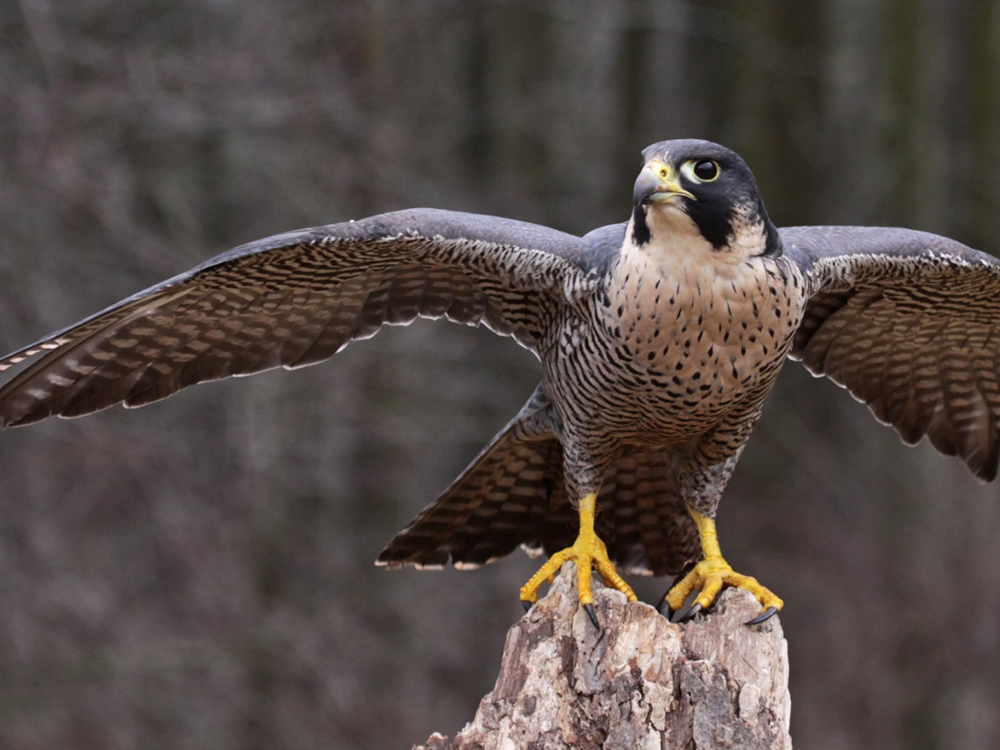In the realm of avian prowess, few creatures command as much awe and admiration as the Peregrine Falcon (Falco peregrinus). With its unparalleled speed, breathtaking aerial acrobatics, and keen hunting prowess, the Peregrine Falcon stands as a testament to nature’s perfection in design. From ancient mythology to modern-day conservation efforts, this magnificent raptor has captivated the hearts and minds of humans for centuries.
Anatomy and Physiology
The Peregrine Falcon is a masterfully engineered predator, finely tuned for life in the skies. With a sleek, streamlined body and long, pointed wings, it is built for speed and agility. Its tapered wings allow it to slice effortlessly through the air, reaching speeds of up to 240 miles per hour (386 kilometers per hour) during its characteristic hunting stoop, making it the fastest animal on the planet.
One of the most striking features of the Peregrine Falcon is its sharp, hooked beak, perfectly adapted for tearing into its prey. Its keen eyesight, eight times more powerful than that of humans, enables it to spot prey from great distances, while specialized nostrils ensure smooth airflow during high-speed pursuits. Its talons, equipped with razor-sharp claws, deliver a swift and lethal strike to capture its quarry mid-flight.
Habitat and Distribution
Peregrine Falcons are a cosmopolitan species, found on every continent except Antarctica. They inhabit a diverse range of ecosystems, from coastal cliffs and mountainous regions to urban landscapes. Despite their adaptability, they are particularly fond of open habitats where they can soar and hunt with ease, such as grasslands, deserts, and tundra.
Historically, Peregrine Falcons were threatened by habitat loss, pesticide poisoning, and persecution. However, concerted conservation efforts, including the banning of harmful pesticides like DDT, have led to remarkable recoveries in many regions. Today, these majestic birds live in urban environments, nesting on skyscrapers and bridges, a testament to their resilience and adaptability.
Behavior and Reproduction
Peregrine Falcons are solitary creatures for much of the year, coming together only during the breeding season. Courtship displays involve breathtaking aerial acrobatics, with males performing elaborate flights to impress potential mates. Once paired, the bond between mates is strong, often lasting for life.
Nesting sites are carefully chosen, typically on cliffs or tall structures that provide a vantage point for hunting and protection from predators. Both male and female Falcons participate in building the nest, which consists of a shallow scrape lined with twigs, grass, and feathers.
Females lay a clutch of 3-4 eggs, which they incubate for approximately 29-32 days. During this time, the male provides food for the female, ensuring her well-being and the success of the nest. Once the chicks hatch, both parents play an active role in feeding and protecting them until they are ready to fledge, usually around 5-6 weeks of age.

Ecological Importance
As apex predators, Peregrine Falcons play a crucial role in maintaining the balance of ecosystems. By controlling populations of prey species such as pigeons, starlings, and shorebirds, they help prevent overgrazing and maintain the health of ecosystems. Furthermore, their presence serves as an indicator of environmental health, as declines in populations can signal broader ecological imbalances.
In addition to their ecological importance, Peregrine Falcons also hold cultural significance for many indigenous peoples and communities around the world. Revered for their speed, grace, and hunting prowess, they feature prominently in mythology, folklore, and art across various cultures, symbolizing power, freedom, and the beauty of the natural world.
Conservation Challenges and Future Outlook
While Peregrine Falcon populations have rebounded in many regions, they still face numerous threats in the modern world. Urbanization, habitat loss, and collisions with man-made structures pose significant challenges, particularly in densely populated areas. Climate change also presents new challenges, altering habitat suitability and disrupting prey populations.
Despite these challenges, ongoing conservation efforts give hope for the future of Peregrine Falcons. Collaborative initiatives involving governments, conservation organizations, and concerned citizens are essential for protecting critical habitats, reducing human-wildlife conflicts, and mitigating the impacts of climate change.
Conclusion
The Peregrine Falcon stands as a symbol of resilience, adaptability, and the power of conservation. From its breathtaking aerial displays to its vital role in maintaining healthy ecosystems, this magnificent bird continues to inspire awe and admiration in people around the world. As we strive to protect and preserve our natural heritage, let us ensure that the Peregrine Falcon soars high for generations to come, a testament to the enduring beauty and wonder of the natural world.









